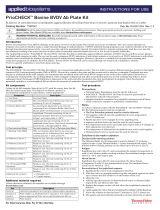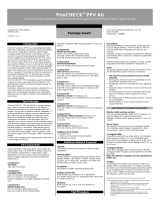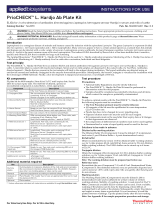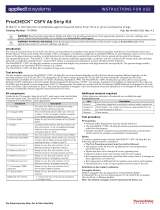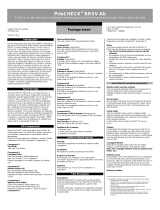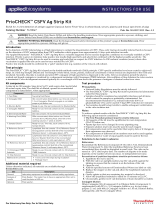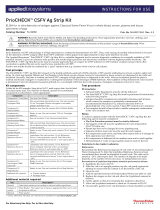Page is loading ...

For Veterinary Use Only. For In Vitro Use Only.
INSTRUCTIONS FOR USE
PrioCHECK™ Bovine BVDV PI focus Ag Strip Kit
ELISA for
in vitro
detection of Bovine Viral Diarrhea Virus antigen in ear notch tissue of cattle
Catalog Number 7610140
Pub. No. MAN0013846 Rev. A.0
WARNING! Read the Safety Data Sheets (SDSs) and follow the handling instructions. Wear appropriate protective eyewear, clothing, and
gloves. Safety Data Sheets (SDSs) are available from thermofisher.com/support.
WARNING! POTENTIAL BIOHAZARD.
Read the biological hazard safety information at this product’s page at thermofisher.com. Wear
appropriate protective eyewear, clothing, and gloves.
Introduction
The bovine virus diarrhea virus (BVDV) infections cause large annual economic losses to the cattle industry. Additionally BVDV has also got a negative
impact on animal welfare.
The Applied Biosystems™ PrioCHECK™ Bovine BVDV PI focus Ag Strip Kit is specifically designed to detect persistently infected (PI) animals with a very
high specificity. The test detects different subtypes of BVDV (Ia, Ib, and II) antigen in ear tissue samples originating from cattle.
The PrioCHECK™ Bovine BVDV PI focus Ag Strip Kit test can be used to diagnose persistent infections of BVDV in individual animals. Moreover, the test is
a valuable tool in large-scale screening and eradication programs.
Validation data show that by the presence of maternal antibodies in the ear sample tissue the Ag-result can be influenced (shielding). As a consequence
ELISA-tests can show an incomplete sensitivity for persistently infected (PI) animals. Therefore an additional control for the presence of BVDV antibodies in
ear sample tissue of animals under the influence of maternal antibodies is recommended.
Test principle
The PrioCHECK™ Bovine BVDV PI focus Ag
Strip Kit ELISA employs two monoclonal
antibodies (mAb’s). The two mAb’s recognize
different epitopes located on the highly
conserved NS-3 non-structural protein (p80)
of BVDV. One mAb is coated to the plate and
the second mAb is used as a conjugate. For
antigen detection undiluted ear tissue
samples are simultaneously incubated with
buffer in the wells of the coated plate. This
incubation step is followed by a washing
step. Subsequently, the working dilution of
the Horse radish peroxidase conjugate is
dispensed and after an incubation period a
second washing step follows. In the subsequent step Chromogen (TMB) Substrate is dispensed to the wells
and after incubation the color development is stopped and the optical density at 450 nm is measured.
During the first incubation period BVDV antigens present in the sample will bind to the coated BVDV
specific monoclonal antibodies. Subsequently, the plates are washed and incubated with a Horse radish
peroxidase conjugated BVDV-specific monoclonal antibodies (mAb against another epitope of NS-3).
Finally, the bound Conjugate and therefore BVDV-antigen from the test sample is visualized by adding a
Chromogen (TMB) Substrate. In the case of a positive sample color development will be visible. In case of
a negative sample there will be no color development.
Kit components
10 plate kit for 900 samples. Store kit at 5±3°C until expiry date. See kit label for actual expiry date. The
shelf life of diluted, opened or reconstituted components is noted below, when appropriate.
Component
Description
1: Test Plate
Ten strip Test Plates.
2: Extraction Buffer
Ready-to-use. Four vials, each containing 60 mL Extraction Buffer.
3: Extraction Buffer Additive
Lyophilized. Four vials, each vial contains Extraction Buffer Additive for one vial
of Extraction Buffer. Shelf life of Extraction Buffer Solution: 1 month at 5±3°C.
4: Conjugate (30x)
Two vials, each vial contains 2.5 mL Conjugate. Diluted conjugate not stable,
prepare just before use.
5: Conjugate Buffer
Ready-to-use. Two vials, each vial contains 60 mL Conjugate Buffer.
6: Dilution Buffer
Ready-to-use. Two vials, each vial contains 60 mL Dilution Buffer.
7: Washing Fluid (200x)
200x concentrated, dilute before use. One vial contains 60 mL Washing
Fluid. Shelf life of washing solution: 1 week at 22±3°C.
8: Reference 1
Lyophilized. One vial contains 2.0 mL Reference 1. Shelf life of reconstituted
reference 1: until expiry date at −20°C.
9: Reference 2
Lyophilized. One vial contains 2.0 mL Reference 2. Shelf life of reconstituted
reference 2: until expiry date at −20°C.
10: Reference 3
Lyophilized. One vial contains 2.0 mL Reference 3. Shelf life of reconstituted
reference 3: until expiry date at −20°C.
11: Chromogen (TMB) Substrate
Ready-to-use. Two vials, each vial contains 60 mL Chromogen (TMB)
Substrate.
12: Stop Solution
Ready-to-use. Two vials, each vial contains 60 mL Stop Solution.
Additional kit contents
• Package Insert
• 20 plate sealers to cover the strips during incubation
Additional material required
Use
Description
(1)
General
Laboratory equipment according to national safety regulations.
Analysis of
results
Plate Reader. The reader has to have an appropriate filter set to read the plates at 450 nm.
Optional
Plate washer. Liquid handler.
(1) Unless otherwise indicated, all materials are available through thermofisher.com.

2 PrioCHECK™ Bovine BVDV PI focus Ag Strip Kit Instructions for Use
Test procedure
Precautions
• National Safety Regulations must be strictly followed.
• The PrioCHECK™ Bovine BVDV PI focus Ag Strip Kit must be
performed in laboratories suited for this purpose.
• Samples should be considered as potentially infectious and all items
which contact the samples as potentially contaminated.
Notes
To achieve optimal results with the PrioCHECK™ Bovine BVDV PI focus
Ag Strip Kit, the following aspects must be considered:
• The Test Procedure protocol must be strictly followed.
• All reagents of the kit must be equilibrated to room temperature
(22±3°C) before use.
• Pipette tips have to be changed for every pipetting step.
• Separate solution reservoirs must be used for each reagent.
• Kit components must not be used after their expiry date or if changes in
their appearance are observed.
• Kit components of different kit lot numbers must not be used together.
• Demineralized or water of equal quality must be used for the test.
• Only fresh ear notch tissue samples that have been well preserved by
desiccation should be tested. Macerated tissue should not be used for
testing.
Solutions to be made in advance for extraction of the test samples
Extraction buffer solution
Equilibrate the vials to 22±3°C and reconstitute the Extraction Buffer
Additive (Component 3) with Extraction Buffer (Component 2) and add the
complete content of one vial extraction buffer additive to one vial of
Extraction Buffer.
Stability of Extraction Buffer solution: 1 month at 5±3°C.
Preparatory steps
1. Transfer the ear notch sample from the sample container into a deep
well plate.
2. Add 200 µL of extraction buffer solution to the deep well plate.
3. Incubate overnight (12 to 18 hours) at 22±3°C.
Solutions to be made in advance
Conjugate dilution
Dilute Conjugate (30x) (Component 4) 1:30 in Conjugate Buffer
(Component 5); e.g. for one plate prepare 12 mL (add 400 µL Conjugate
(30x) to 11.6 mL Conjugate Buffer).
Note: The diluted conjugate must be prepared just before use.
Washing solution
Dilute Washing Fluid (200x) (Component 7) 1:200 in demineralized water.
The amount of Washing Fluid is sufficient to prepare a final volume of
12 liters washing solution.
Stability of washing solution: 1 week stored at 22±3°C.
Remark: Commercial available ELISA washers can be used. If not available,
washing of the Test Plates can be done by dispensing at least 200 µL of
washing solution to all wells of the Test Plate. Subsequently, empty the Test
Plate and repeat as many times as prescribed. It is not necessary to soak the
Test Plate between washings. Tap the Test Plate firmly after the last
washing step.
Reference 1–3
Equilibrate the vials to 22±3°C and reconstitute the Reference 1–3
(Component 8–10) with 2.0 mL Dilution Buffer (Component 6). The
reconstituted references can be stored in portions of 150 µL at −20°C until
expiry date.
Reconstitution of the lyophilized material should be performed as follows:
1. Equilibrate the vial to 22±3°C.
2. With the vial in an upright position, tap the vial gently against the
worktop to ensure that the content is on the bottom of the vial.
3. Carefully open the vial.
4. Add the specified amount of Dilution Buffer (Component 7).
5. Replace the stopper on the vial and allow the lyophilized material to
dissolve.
6. Gently agitate the vial so that any remaining dry material will be
dissolved.
7. Allow the material to stand at least for 15 minutes at 22±3°C before use.
8. Mix gently and intermittently (formation of foam should be avoided).
Incubation of test samples
Antigen detection:
1. Label each strip of the Test Plate (Component 1) with a marker pen.
2. Dispense 50 µL of Dilution Buffer (Component 6) to all wells.
3. Dispense 50 µL of Reference 1 to the wells A1 and B1 (= OD max).
4. Dispense 50 µL of Reference 2 to the wells C1 and D1.
5. Dispense 50 µL of Reference 3 to the wells E1 and F1 (= OD blank).
6. Dispense 50 µL of the test samples into the remaining wells.
7. Seal the Test Plate and shake it gentle.
8. Incubate for 60±10 minutes at 22±3°C.
Incubation with conjugate
1. Empty the Test Plate and wash it 6 times with washing solution. Tap
the plate firmly after the last wash cycle.
2. Dispense 100 µL of diluted conjugate to all wells.
3. Seal the Test Plate.
4. Incubate the Test Plate for 60±10 minutes at 22±3°C.
Incubation with Chromogen (TMB) Substrate
1. Empty the Test Plate and wash it 6 times with washing solution. Tap
the plate firmly after the last wash cycle.
2. Dispense 100 µL of the Chromogen (TMB) Substrate (Component 11) to
all wells.
3. Incubate the Test Plate for 15 to 25 minutes at 22±3°C.
4. Add 100 µL of Stop Solution (Component 12) to all wells.
5. Mix the contents of the wells of the Test Plate.
Note: Start the addition of Stop Solution 15 to 25 minutes after the first well
was filled with Chromogen (TMB) Substrate. Add the Stop Solution in the
same order and at the same pace as the Chromogen (TMB) Substrate was
dispensed.
Reading of the test and calculating the results
Measure the optical density (OD) of the wells at 450 nm within 20 minutes
after color development has been stopped.
Calculate the mean OD450 of wells E1 and F1 (= OD blank).
Calculate the corrected OD450 of all samples by subtracting the OD blank.
Calculate the mean of the corrected OD450 of wells A1 and B1
(= corrected OD max).
Calculate the percent positivity (PP) of Reference 2 and of the test samples
according to the formula below.
Note: The corrected OD450 of all samples is expressed as percent positivity
(PP) relative to the corrected mean OD450 of wells A1 and B1
(= corrected OD max).
PP = (corrected OD450 test sample / corrected ODmax) × 100%
Result interpretation
Validation criteria BVDV-Ag test
1. The mean OD450 of Reference 3 (= OD blank) must be ≤0.300.
2. The corrected OD450 of Reference 1 must be ≥0.800.
3. The percent positivity of Reference 2 must be <30%.
Not meeting these criteria is reason to discard the results of that specific test
plate.
Note: If the corrected OD max is below 0.800 possibly the Chromogen
(TMB) Substrate is too cold. In that case prewarm the solution to 22±3°C or
incubate up to 30 minutes.
Interpretation of BVDV-Ag test
PP = ≥20%
Positive
BVDV-antigen present in the test sample.
PP = <20%
Negative
No detectable antigen present in the test sample.
Note: PrioCHECK™ Bovine BVDV PI focus Ag Strip Kit is a highly specific
test for the detection of PI-animals. However, if there is any doubt about the
status of a valuable, positive live animal, retest another sample collected
2–3 weeks (ELISA) or 6 weeks (PCR/NASBA) after the initial sample was
collected to confirm persistent infection.

thermofisher.com/support
|
thermofisher.com/askaquestion
thermofisher.com
1 October 2019
Customer and technical support
Technical support: visit thermofisher.com/askaquestion
Visit thermofisher.com/support for the latest in services and support,
including:
• Worldwide contact telephone numbers
• Order and web support
• User guides, manuals, and protocols
• Certificates of Analysis
• Safety Data Sheets (SDSs; also known as MSDSs)
NOTE: For SDSs for reagents and chemicals from other manufacturers,
contact the manufacturer.
Limited product warranty
Life Technologies Corporation and/or its affiliate(s) warrant their products
as set forth in the Life Technologies' General Terms and Conditions of Sale
found on Life Technologies' website at www.thermofisher.com
/us/en/home/global/terms-and-conditions.html. If you have any questions,
please contact Life Technologies at thermofisher.com/support.
Prionics Lelystad B.V. | Platinastraat 33 | 8211 AR Lelystad | The Netherlands
The information in this guide is subject to change without notice.
DISCLAIMER: TO THE EXTENT ALLOWED BY LAW, LIFE TECHNOLOGIES AND/OR ITS AFFILIATE(S)
WILL NOT BE LIABLE FOR SPECIAL, INCIDENTAL, INDIRECT, PUNITIVE, MULTIPLE, OR
CONSEQUENTIAL DAMAGES IN CONNECTION WITH OR ARISING FROM THIS DOCUMENT,
INCLUDING YOUR USE OF IT.
Revision history of Pub. No. MAN0013846 (English)
Rev.
Date
Description
A.0 1 October 2019
New document. Converted the legacy document (PrioCHECK BVDV Ag
PIfocus 10plate_v2.1_e.doc) to the current document template, with
associated updates to the publication number, limited license
information, warranty, trademarks, and logos.
Important Licensing Information: These products may be covered by one or more Limited Use Label
Licenses. By use of these products, you accept the terms and conditions of all applicable Limited Use
Label Licenses.
©2019 Thermo Fisher Scientific Inc. All rights reserved. All trademarks are the property of Thermo
Fisher Scientific and its subsidiaries unless otherwise specified.
/
